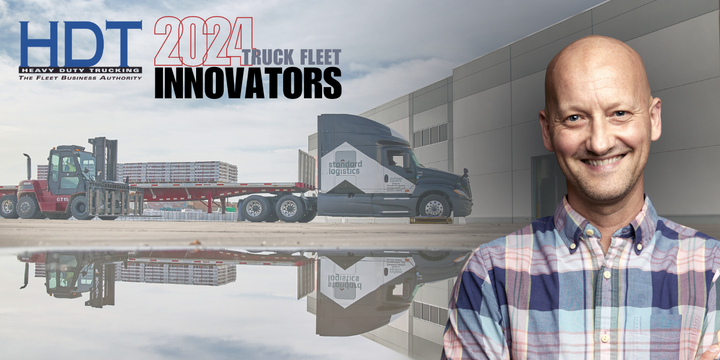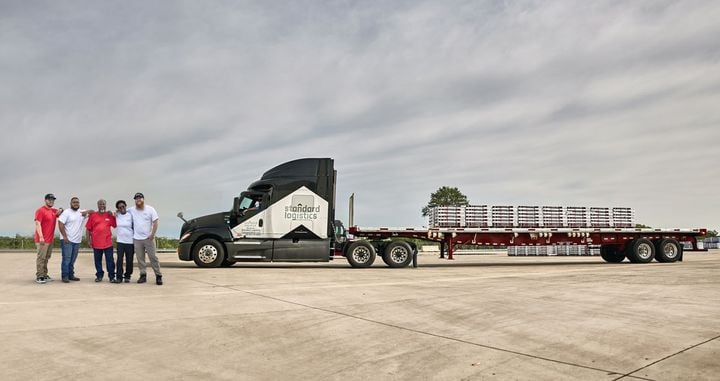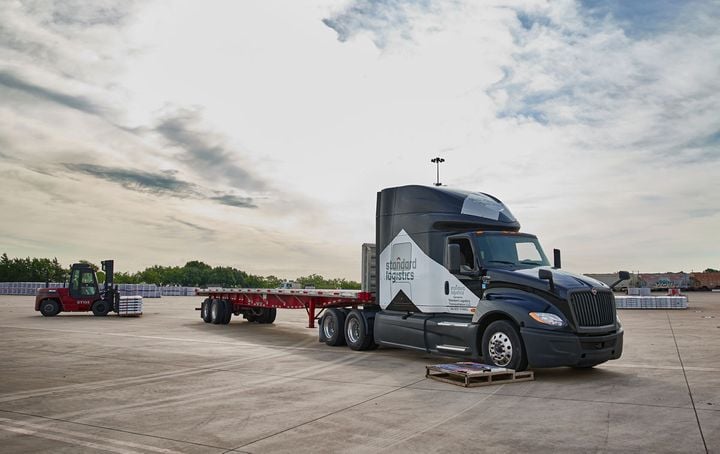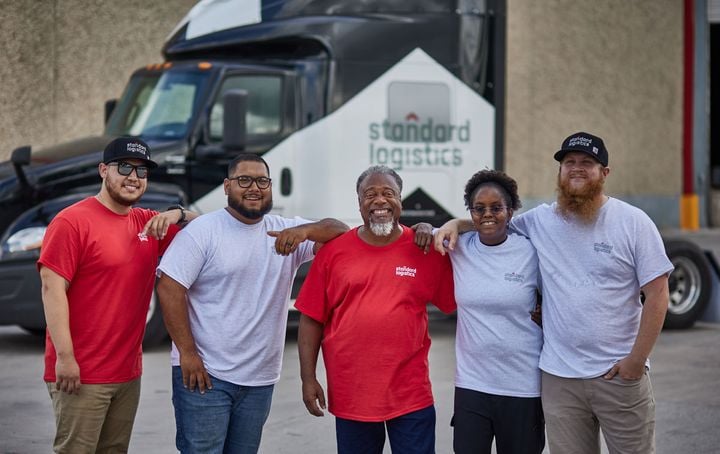Trucker Access › Forums › Diesel News › Turning a Private Fleet Into a Best-of-Class Motor Carrier – Fleet Management
- This topic has 0 replies, 1 voice, and was last updated 5 months, 1 week ago by
 EazyRiDer66.
EazyRiDer66.
-
AuthorPosts
-
June 19, 2024 at 8:45 am #26300
 EazyRiDer66Keymaster
EazyRiDer66Keymaster

HDT 2024 Truck Fleet Innovator Volker Bargenda invests in technology and people for success.
Image: HDT Graphic | Standard Logistics Photos
Volker Bargenda was given a mission when hired by the company that would become Standard Logistics: Take an average private fleet and grow it into a best-in-class trucking operation hauling for outside customers as well as its traditional private-fleet freight.
Bargenda got his start in the industry in 2006, working for DHL Consulting in Germany. In 2011 he moved to North America to start a freight brokerage business for DHL Freight, and was CEO North America of DHL Freight for five years.
In 2021, he became president of Miami-based Standard Logistics. It’s part of Standard Industries, a global industrial company with many different operating companies. GAF, for instance, is the largest roofing and waterproofing manufacturer in the U.S., Bargenda says.
At the time, GAF had a private fleet — but the ownership had made a strategic decision to expand and make it much more than that.
“I was hired with that mandate: Take that private fleet and grow aggressively and see what you can make out of it,” Bargenda says.
“We very quickly launched a freight brokerage business as well. And that’s taken off beyond our wildest expectations.”
The company also bought warehouses in Dallas and Philadelphia.
“We’ve seen literally our revenue grow 6x, roughly from where we were in Q1 of 2021,” he says.
“We’ve had a lot of growth, and had a lot of innovation to support the growth. We really kind of took what was I’d say, a decent private fleet, but it wasn’t, from a process and technology perspective, anything that would sustain considerable growth.
“The systems were outdated. They weren’t really designed to help us grow or bring on external shippers. So we’ve added a lot of new technology to support the business, both on the fleet as well as on the brokerage side.”
Today Standard Logistics has a versatile fleet (dry van, flatbed, tanker, pneumatics) with more than 20 locations across the country and more than 400 drivers.
Using Technology to Optimize and Grow the Business
“Within a few months of me starting, I felt, if we’re going to grow, we’re not going to be able to dispatch and optimize how we run the fleet by using Google Sheets and just kind of making it up as we go along,” Bargenda says.
“We needed software to help us make the right decisions, to help us pick the right loads to optimize the driver time, the asset utilization, all that.
“So we very early on embarked on a journey with Optimal Dynamics.”
Optimal Dynamics uses artificial intelligence to help motor carriers make better decisions, optimize EDI tender acceptance, bidding workflow, and dispatching.
“How do we figure out where we should be growing in the first place? And how do we make sure that whatever investments we make in terms of trucks and people and trailers, how do we make sure that we keep them busy so that there’s a return on the investments?”
People are Key to Getting the Most out of Trucking Technology
Key to that effort is change management, Bargenda says.
“I’m relatively certain, we can always get the technology to work. It comes down to, are the people that are supposed to be on the receiving end of this technology, are they adopting it, and making sure they use it and use it in the way they’re supposed to, and fully utilize it so that we truly get the maximum benefit out of it.”
When making major changes in technology like this, he says, it helps to get input early from the people who it will affect.

Recently Standard Logistics rolled out a driver app where drivers can see all their safety metrics in real time so they know exactly where they are in terms of earning their safety bonus.
Photo: Standard Logistics
“We’ve done a lot of over-communicating what we’re doing and why we’re doing it. We try to make sure that we bring folks in early on in the process to get their buy in, but also get their input and kind of understand, if we did this, how would that change your day? And what would you need to you know to fully buy into this and get the benefits out of it?
“So you may be adding folks to the team that maybe traditionally you wouldn’t necessarily think of that should be part of the project team to get that on the ground perspective.”
How Bargenda Convinces the Standard Logistics Team to Share in His Vision
It also takes a leader with vision — and who can get people to share in that vision.
“Also, to be perfectly blunt, it is pushing pretty hard on my end saying, ‘Here’s the vision, here’s where we’re trying to go. And we all need to make sure that we all pull on the same string to get this done.
“Because if we don’t, the reality is if we don’t leverage this technology, it we don’t use AI, at some point we’re going to be left behind,” Bargenda says.
“We may be able to operate another year or two and do things like everybody else does. But the goal was always to be truly better than everybody else, frankly, and be best in class. And if we want to get there, we’re going to have to implement new technology and adopt it.”

Standard Logistics has a versatile fleet (dry van, flatbed, tanker, pneumatics) with more than 20 locations across the country and more than 400 drivers.
Photo: Standard Logistics
How Technology Supports Company Culture
While technology has been a key part of Standard Logistics’ growth, Bargenda views it as a tool to support the company’s people.
“What we really focus on is on culture and making sure that everybody feels like this is a great place to work,” he says. “We can create this great culture. But the other thing is also, how can we support it with technology?”
Driver retention, for instance.
“We felt like, this is really, really important for us. And then we kind of figure out, how do we actually make this happen?”
The company rolled out a text messaging application for drivers to be able to communicate with them very easily. Instead of having maybe a three-minute touchpoint with drivers when they pick up their paperwork, he said, this allows for the company to send drivers questionnaires, updates, and more.
Recently the company rolled out a driver app where drivers can see all their safety metrics in basically real time and they know exactly where they are in terms of earning their safety bonus.
“If I’m off track, where am I off track? Is it because I’m speeding too much, or hard braking?”
Bargenda says the drivers can use the app to ask questions, make suggestions for improvement, give each other shout-outs, and more.
“So we’re leveraging technology to foster that culture that we’re shooting for. And I think that’s helped us attract and retain drivers. And obviously, that helps us fuel our growth.”
Investing in the Right People
Technology is only one piece of the puzzle to successfully growing the company, Bargenda says.
“We invest a lot in our people. We’re truly trying to build the best team we can possibly build.”
That starts with an outside-the-box hiring philosophy.
“We put a lot of effort into making sure we recruit the right people to join us. My thing is, how are they going to make us better? If you’re just another person that’s been doing this for 30 years, yeah, you’re good at it. But if all you bring is experience, not necessarily a fresh perspective, or challenging the status quo, or telling us how we can potentially improve, then maybe you’re not the person we’re looking for.
“We’re looking for people that really tell us, it’s great what you’ve been doing, but we should be trying different things, too.”
Then Standard Logistics invests in those people, for instance through training such as the National Private Truck Council’s CTP certification process (Certified Transportation Professional.)
Defining a Cultural DNA for Standard Logistics
“About two years ago, we actually wrote down what the Standard Logistics cultural DNA is,” Bargenda says. “It’s got different buckets, and it’s got bullet points and pretty detailed descriptions underneath — who we are as a company, what’s important to us, and how we do business. There’s things about entrepreneurial spirit, about ownership — you know, if you’ve got a problem, you figure out a solution, you own it until it’s done, instead of just kind of handing it off.”
“So it’s a long list of things that, everybody’s aware of, everybody’s aligned with.”

Diversity is important to Bargenda, who personally heads up one of the employee resource groups.
Photo: Standard Logistics
Diversity and inclusion is in there as well, which Bargenda says is very important to him.
“Half of our senior leadership team is female, which I’d say in the logistics business is unusual. We’ve got a lot of female leaders below the senior leadership team as well.”
There are employee resource groups, in conjunction with GAF, for groups such as African-Americas, Asians, Latinos, caregivers, and so on. Bargenda is the executive sponsor the LGBTQ+ ERG.
These groups, he says, give employees “another outlet to talk to people with similar backgrounds or going through a similar experience.
“To make sure that it’s not just about work, work, work; we understand, there’s more to it than just the eight or nine or 10 hours that you spend every day.”
“We’ve been pushing pretty hard to make sure that it’s a welcoming place for everybody.”
-
AuthorPosts
- You must be logged in to reply to this topic.